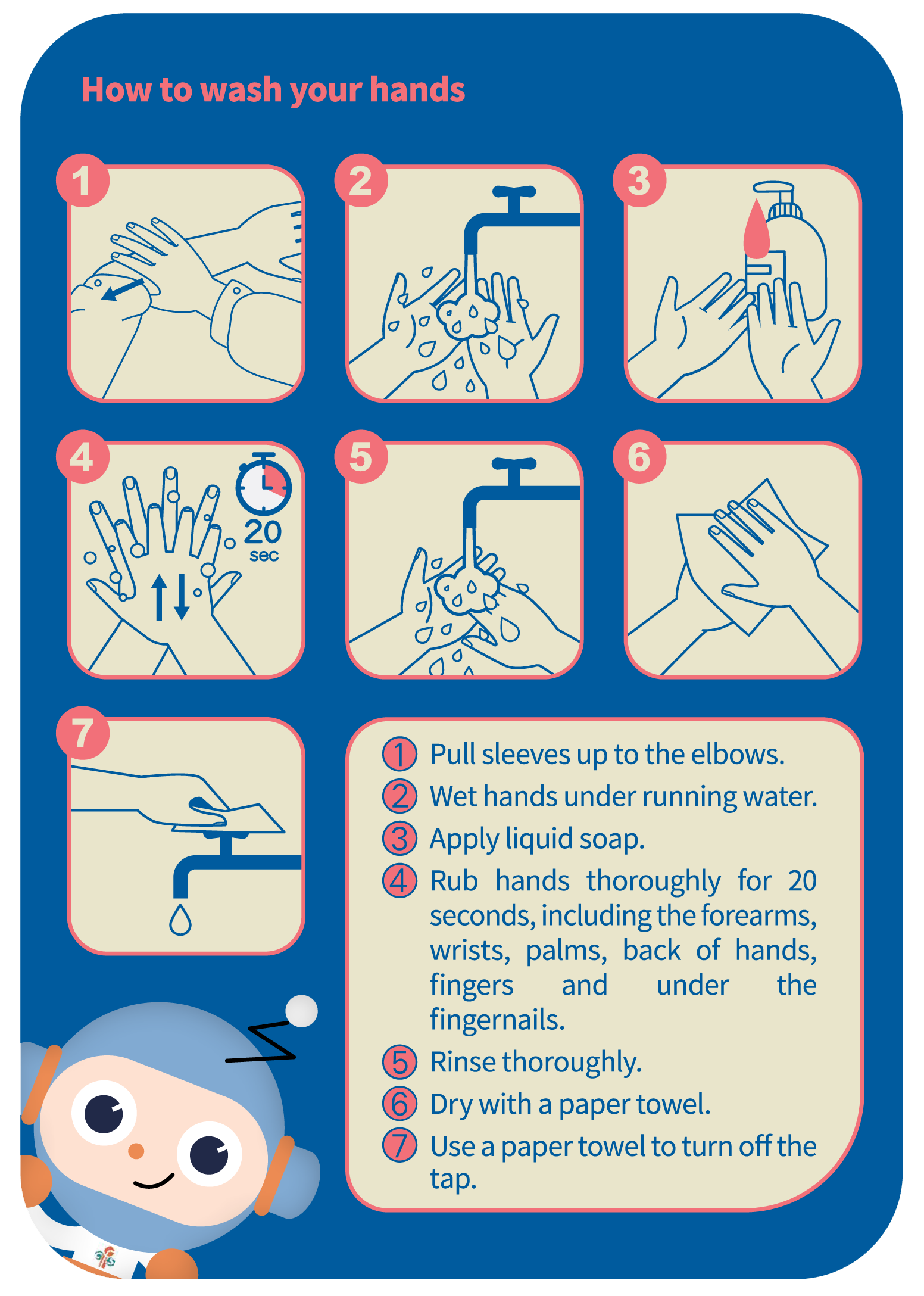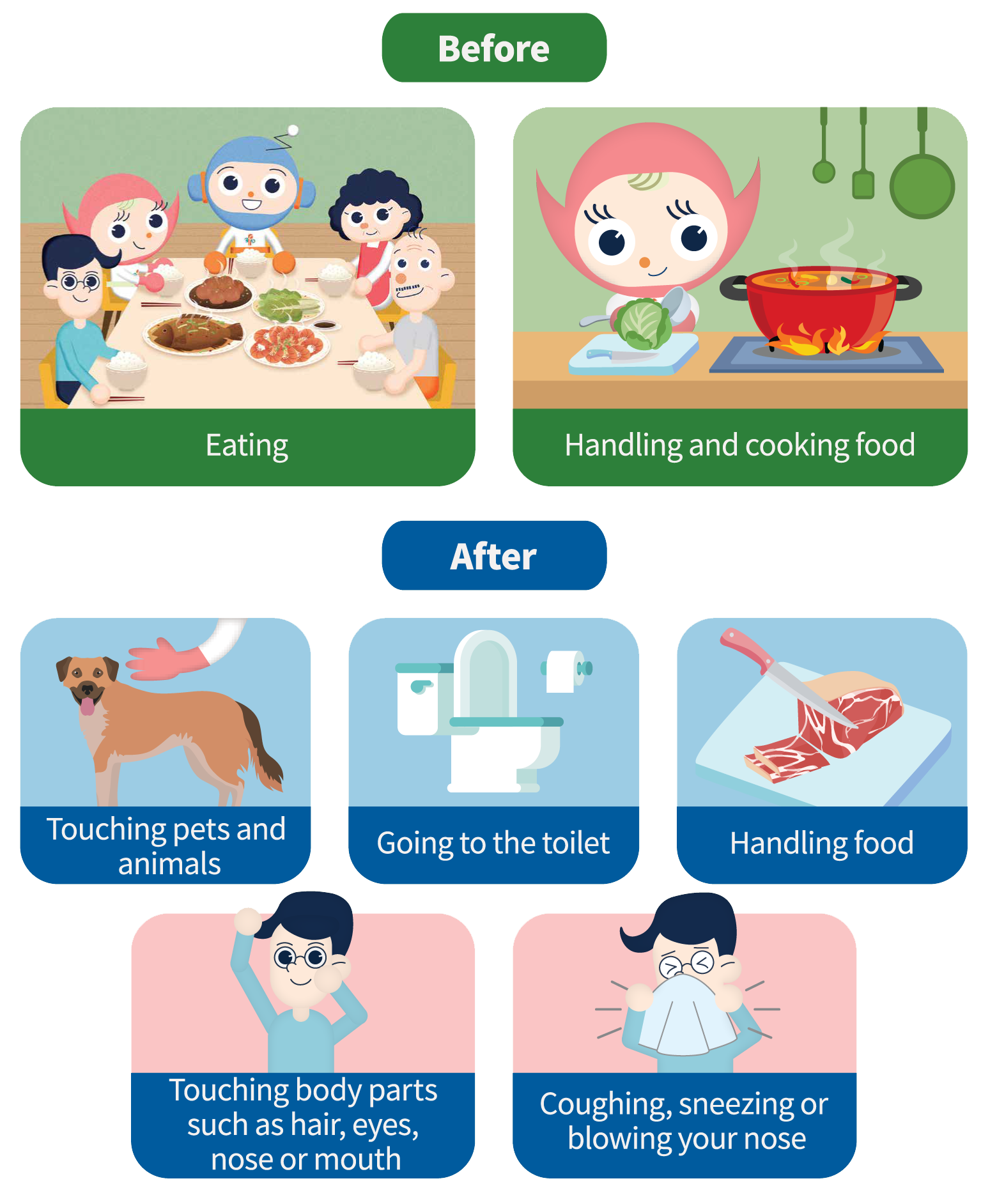Wash Hands
Wash hands thoroughly before preparing, cooking and eating food.
The five steps to proper hand washing include:
- Pull sleeves up to the elbows
- Wet hands under running water
- Apply liquid soap
- Rub hands thoroughly for 20 seconds, including the forearms, wrists, palms, back of hands, fingers and under the fingernails
- Rinse thoroughly
- Dry with a paper towel
- Use a paper towel to turn off the tap

When should you wash your hands?
Before:
- Eating
- Handling and cooking food
After:
- Going to the toilet
- Touching pets and animals
- Handling food
- Touching body parts such as hair, eyes, nose or mouth
- Coughing, sneezing or blowing your nose

When feasible, wash hands with warm water and liquid soap - liquid soap and warm water work more effectively than disinfectant wet wipes or hand sanitisers for removing dirt, grease and certain microorganisms that cause food poisoning. If handwashing is not possible (e.g. when having a picnic and hands are not visibly dirty), hand sanitisers or disinfectant wet wipes can be used to clean hands before handling food.
Pathogens and "Superbugs"
Using warm water and liquid soap to clean or sanitise cleaning products can effectively remove harmful pathogenic bacteria and "superbugs". Therefore, you should clean regularly:
- Hands
- Cutting boards, cutleries
- Cooking tools and tableware
- Work surfaces and other food contact surfaces
Washing with warm water and liquid soap does not directly kill bacteria. To kill bacteria, washing surfaces above 70°C for a period of time can kill bacteria, but it can also burn your hands. The foam produced from warm water and detergent together with scrubbing can remove microorganisms from surfaces, and washed away with running water.
Although it can be washed with cold water, warm water can make the liquid soap foam normally, and the washing time will not be shortened due to the cold water. Sufficient lathering of the liquid soap can remove bacteria more effectively.
Cleaning Kitchen Utensils
Wiping Cloths
Dirty, damp wiping cloths tend to harbour bacteria. Wash or replace wiping cloths, sponges and insulating gloves regularly and allow them to air dry thoroughly before using them again.
Cooking utensils and cutlery
Before preparing food, take care to keep all cooking utensils and utensils clean to avoid cross-contamination of food. When serving ready-to-eat meals and raw meals, use different tools, utensils and cutting boards to handle them separately. Remember to wash utensils thoroughly after handling food to prevent the spread of pathogenic bacteria.
Washing Food
Raw meat and poultry
Washing raw meat and poultry is risky. The bacteria in splashes can contaminate hands, clothing, utensils and work surfaces. If washing raw meat and poultry is necessary, subsequent thorough cleaning of the sink and its surrounding areas within about one meter are very important to prevent cross-contamination.
When washing raw meat and poultry, the bacteria in splashes can contaminate nearby surfaces, utensils or food. If washing is necessary, thorough cleaning of the sink and its surrounding areas is very important to prevent cross-contamination.
Fruits and Vegetables
Remember to wash fruits and vegetables before eating thoroughly under running water to make sure the food is clean. Details on how to properly clean fruits and vegetables, please click here.
Cleaning Agents
There are a variety of products on the market for cleaning and disinfection. In order to effectively eliminate pathogenic bacteria and ensure safety and health, you should:
- Make sure the product is suitable for food surfaces (food grade).
- Leave the cleaning product on the surface to be cleaned for the retention time specified in the manufacturer's instructions.
- Read the manufacturer's instructions carefully to see if the product needs to be diluted before use.
- Be aware that products are classified as cleaners, disinfectants or cleaning disinfectants.
| Detergent |
|
|---|---|
| Disinfectant |
|
| Sanitiser |
|